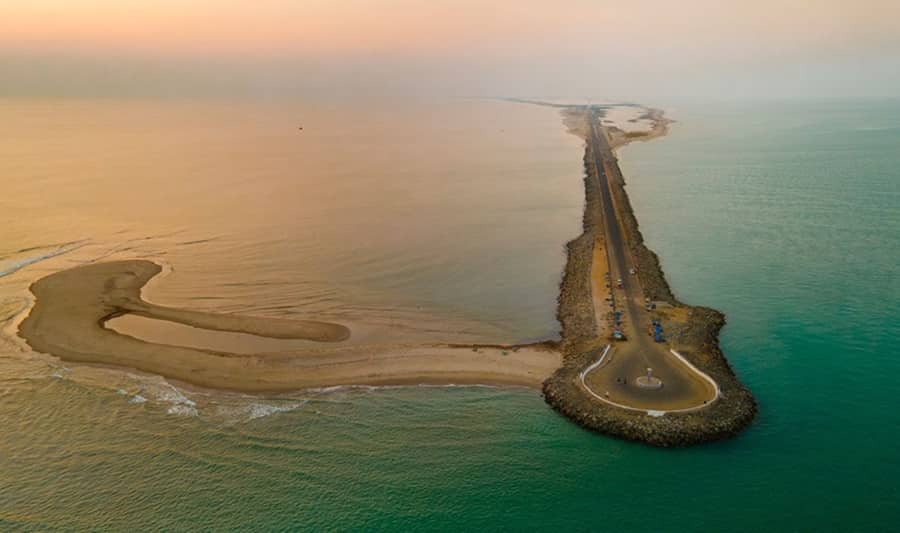Dhanushkodi also known as Dhanushkoti is the south eastern tip of India, a ghost- town (abandoned village) from where Sri Lanka is clearly visible. Situated in the south-east of Pamban town in Rameshwaram block of Ramanathapuram district in Tamil Nadu, Dhanushkodi is the only land border between India and Sri Lanka. It measures only 45 meters in length and falls on the list of smallest places in the world. Belief of Dhanushkoti as a haunted place is getting stronger and tough by the time and the rumours resulted in the form of ban over roaming after sunset. The visitors must plan the visit to DhanushKoti in such a manner that they return to Rameshwaram by evening as the whole pathway of 15 KM is full of loneliness, mysteries and dreadful experiences.

With the spread of rumours, tourism is rising in Dhanushkoti. It won’t be an exaggeration to say that the frequency of tourists at Dhanushkoti has increased in leaps and the rate is greater than any other tourist place in India. Looking to the same, Indian Navy has also set a naval station over here. Meeting of Indian Ocean’s deep and capricious water with shallow and silent water of Bay of Bengal can be seen here. As the ocean is superficial, tourists can move in Bay of Bengal from here and can see colourful fishes, shells, corals and what not.
- Suggested Tour: Rameshwaram Tour Packages
Cyclone Destroyed Dhanushkoti
Colorful life of the recent past can now also be seen in The Ruins at Dhanushkoti. Before the cyclone of 1964 Dhanushkoti was a flourishing tourist and pilgrimage town. As Ceylon (Sri Lanka) is only 18 miles from here, people used to transport goods between Dhanushkoti and Talaimannar (of Ceylon) and to cross the ocean, several ferry services were available. In reference to the needs of these passengers and devoted pilgrims several cloth shops and Inns were available. Dhanushkoti railway line which was not running to Rameshwaram at that time was destroyed in the 1964 Cyclone. It was the direct route from Mandapam to Dhanushkoti. That time, Dhanushkoti had a Railway station, railway hospital, Post Office and some Government Offices like a fish farm etc. This was the scene of an island from January 1897 to the time when Swami Vivekananda came along with his victorious feet from Colombo after taking part from Parliament of Religions held in USA.
Spookily deserted this place is mystically beautiful in real. Although cyclone have really busted the lives here for a time yet Dhanushkoti beach makes for a marvelous sight to behold .Those endlessly stretching silvery and blooming sands attracts the tourism. The fact cannot be denied that the crystal clear water itself says, “Yes, Nature love is calling you”. Age old ruins here makes the place like a dream feeling which cuts a person from this technical and eerie world. Calm, soothing and peaceful mood can be enhanced at heights here in the early morning. Sunrise at Dhanushkodi gives you a remembering and cherishing moment for lifetime.
Dhanushkoti is also known as a sacred spot where Lord Rama himself came here to absolve him of the sins of killing Ravana after defeating Ravana to perform certain rituals as described in Hinduism . The world knows Ravana as a sinful person yet he too possessed a positive side. Ravana was one of the greatest devotees of Lord Shiva, Brahmin by birth and used to come Dhanushkoti.
To reach the shores of Dhanushkoti in an ordinary vehicle is not wise decision as the path is really sandy and hence a vehicle having four wheel drive is needed. Many Hindus go to the shores of Dhanushkoti to perform specific rituals and to have the sacred peacefulness of soul , mind and heart here. The meeting of the oceans, dip in the sea and silent shores makes the visit to Dhanushkoti a memorable and special journey. It is not at all crowded and is a great place for a half a day trip as told earlier .One can also find some shacks selling sea food. It is also known a s career oriented great place to shoot pictures for new photographers who wants to make their career in this field .The pictures of the rising and setting sun are marvellous and quixotic at this spot.
Mythological/Legendary Accreditation
According to the Hindu scripture Ramayana, Lord Rama assembled a causeway, called Ram Setu between the mainland and Sri Lanka, conducive to take his army across. As per the Ramayana, after the legendary victory Lord Rama, he kept his promise and crowned “Vibhishan” as the new king of Lanka. The new king Vibhishan requested Rama to destroy the bridge and Rama broke the bridge with a one end of his bow. That is why the place since then is called as Dhanushkoti alias ‘end of the bow’ (Dhanush meaning ‘bow’ and Koti meaning ‘end’). It is also said by ancestors that Lord Rama spotted this place for the starting end of the causeway by his famous bow.
- Check out: Ramayana Circuit Tour Packages
Hindu pilgrims normally take holy bath here in the sacred confluence of 2 great oceans before starting their journey to Rameshwaram. Described as the broken residuals in a straight chain structure of shoals, coral reefs, a ridge formation is now known as “Ram Setu” or “Adam’s Bridge”. It is said that the pilgrimage to the holy city of Kashi “Mahodadhi” (Bay of Bengal) and “Ratnakar” (Indian Ocean) in North India is not complete without worshipping at Rameswaram, including the ritual bath at Dhanushkoti. “Setu” is a Sanskrit word used to describe causeway/bridge. This bridge, made by Lord Shri Rama to reach and conquer Lanka and get Sita back is now attracting the attention of tourists from India and World.

 Call
Call WhatsApp
WhatsApp Enquiry
Enquiry